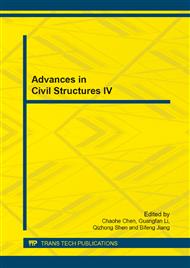p.1374
p.1379
p.1396
p.1400
p.1405
p.1410
p.1415
p.1419
p.1424
Seismic Evaluation and Strengthening Design for a Historic Structure
Abstract:
This study focuses on one of the historic structures located in Shanghai. In order to meet modern occupants’ needs, safety inspection, seismic evaluation and strengthening design for the historic building are carried out. This building, completed in 1930s, was designed without considering the effect of possible earthquakes which cannot meet the current seismic criteria. An analytical investigation of the retrofitted structure is performed. Safety and seismic behavior are analyzed. According to the evaluation, structural performance was better understood which led to the more efficiently use of retrofit methods.
Info:
Periodical:
Pages:
1405-1409
Citation:
Online since:
July 2014
Authors:
Price:
Сopyright:
© 2014 Trans Tech Publications Ltd. All Rights Reserved
Share:
Citation:


